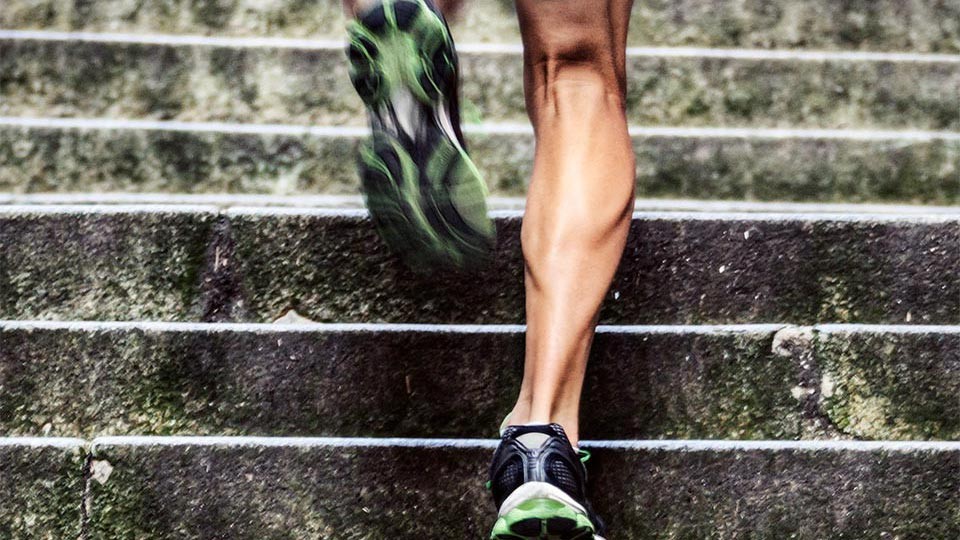RUN BETTER WITH OUR NEWSLETTER
Weekly updates on gear, offers & events
JOIN NOW
Calf muscles are made up of two muscles – gastrocnemius and soleus – positioned at the back of your lower legs.
The ‘bulkiness’ of the calf is created by the gastrocnemius. The soleus lies underneath and has a flatter shape. Both muscles connect at the bottom and are attached to the Achilles tendon by connective tissues. Calf muscles pull the heel up, allowing body to move, jump, walk, etc.
Calf muscles literally allow you to move forward by lifting your heel. Without those important (and somehow often neglected) muscles you wouldn’t even move.
The calf muscles contract, lift your heel and propel you upward and forward by producing that final push of your every step. Therefore, the strength of your calf muscles determines your explosive power, stride and pace.
Strong calves also prevent you from many injuries and support your posture. They absorb the impact from running, protecting your tibia and fibula bones from stress fracture and your shins from shin splints. Also, if you’re struggling with Achilles issues, pay a bit more attention to your calf strength.
Absolutely! Strong calves improve your leg strength by increasing the cadence and explosiveness of your stride.
Basically, your feet are touching the surface more often and with a faster and stronger push-off. That’s what’s going to improve your speed. If you often run on hills, don’t neglect strengthening your calves. You’re going to notice a massive, positive difference in both your uphill and downhill speed and technique.
Incorporating lower body exercises, especially ones targeting your gastrocnemius and soleus, is the best way to strengthen your muscles.
However, you can also do other things that enhance the muscles of your lower legs. Walking barefoot, exercising without shoes, doing yoga – basically any barefoot movements – massively strengthen your calves and feet.
I could see a massive change in my calf shape and strength after incorporating running in lower-drop shoes (offset below 4mm). However, when you decide to move towards running in minimal shoes, make sure that your technique is appropriate. Check out Technique Coaching for more information, or read more in Transition to Minimalist Running Shoes.
Check out the video below with 3 simple and quick calf-strengthening exercises, from the most basic (great for beginner or post-injury) to more explosive options.
You can do them as a stand-alone workout or incorporate them somewhere into your day – for example when walking up the stairs (calf raises) or as a part of a pre-run warm up (high knees).
Take a short break between the following sets:
It’s good to incorporate calf strengthening exercises 2-3 times a week.
They don’t take up too much of your time, because it’s a small area of your body. I like to incorporate calf raises somewhere during the day when I walk up the stairs. I just stop for a 2-minute super-fast session; there’s no need for more!
We don’t recommend running with obvious soreness or pain because that’s a risky game!
You can really worsen the condition and delay your recovery. It doesn't take much to get a calf strain when you're overtraining tight muscles. Instead, we suggest focusing on stretching for a little bit. Improving calf flexibility is really important in preventing calf strain and soreness in the future. Check out Calf Muscles and Running: Injury and Care.
The best running shoes for tight calves are... new and with the appropriate level of support.
Avoid continuing to run with your shoes if your mileage has gone past the 400-mile mark. The high impact of running damages the cushioning and support of the shoe. Basically, all the impact then goes right into your body.
Also, the most supportive shoes aren’t necessary the best for you if you need mild support, or no support at all. Having shoes with too much stabillity pushes you off your natural stride, causing stress on the outer side of your legs.
That’s why choosing the right level of both cushioning and support is so important. Find out more about our Natural Gait Analysis service for personalised service.
These are exercises that we've found very useful and want to share with our customers. But we're not certified instructors. Always consult your specialist before beginning any exercise programme. This general information is not intended to diagnose any medical condition or to replace your healthcare professional. Consult with your healthcare professional to design an appropriate exercise prescription. If you experience any pain or difficulty with these exercises, stop and consult your healthcare provider.
NicoleOctober 26, 2021 at 8:32am
Thanks for these tips, they are just what I need for my calves right now. Plus the instructions are super easy to follow. ReplyGoska DuzykOctober 29, 2021 at 5:00pm
Hi Nicole, I'm glad you liked the video and found the exercises actually working for your calves! Have fun! Goska Reply